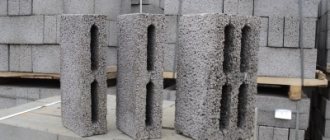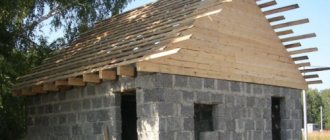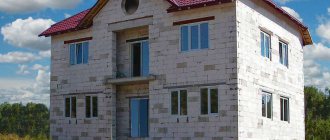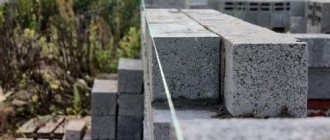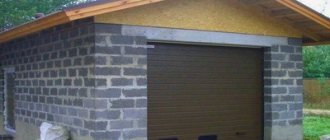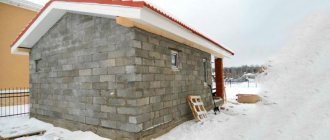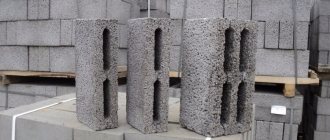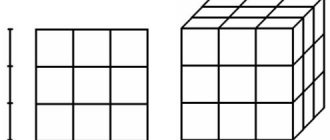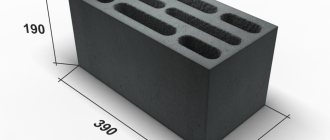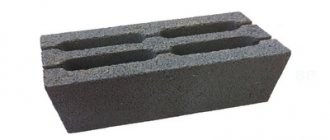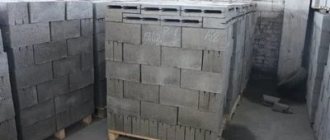Block expanded clay concrete is convenient to use for the construction of walls not only of a residential building, but also of commercial buildings, as well as garages, cellars, sheds.
It is easy to use and fits well into the masonry. To know the properties and features of this material, it is necessary to study its composition.
You can prepare a solution for the production of stone with your own hands.
What does expanded clay block consist of?
A high-quality expanded clay block consists of components that have previously passed certification. This is Portland cement of a certain brand, expanded clay fractions, fine sand dispersion, and also water are needed. In this case, Portland cement acts as a binder. All ingredients have requirements that must also be observed when making the stone yourself.
The composition of expanded clay concrete blocks is described in this video:
Binding components
Portland cement is used as a binding ingredient . For expanded clay blocks, it must have certain characteristics and comply with GOST 10178-85:
- brand not lower than M400;
- cement may be without additives or may have mineral additives;
- the tensile strength of cement in bending must be at least 5.4 (55) MPa (kgf/cm);
- the compressive strength should not be less than 39.2 (400) MPa (kgf/cm);
- The beginning of setting should occur no earlier than 45 minutes after preparation.
The more Portland cement you add to the stone, the stronger it will be. If you use low-grade material, the volumetric weight of the finished block will decrease. Because of this, it is recommended to use Portland cement of a grade no lower than M400.
Water
Requirements for the quality of water for the solution are agreed upon in the document GOST 23732-79, which defines the standards and acceptable characteristics of the liquid for concrete.
It says here that water should not contain impurities , but if they do exist, then their amount should not exceed 10 mg/liter.
The solution water should not contain petroleum products, fats or oils. Also, there should be no coloring impurities.
It is best to use tap water at room temperature; it should not be hot or very cold. It is prohibited to use water from lakes and seas for the composition.
Also, the water must contain a certain amount of soluble salts, ions and suspended particles. Standard indicators are determined by taking a sample and conducting an examination of the liquid . The oxidation of water should not be more than 15 mg per liter.
Expanded clay and sand
Sand and expanded clay are considered fillers for expanded clay concrete stone. There are also several requirements for their quality. For example, some manufacturers use coarse or medium sand to create a good frame for the future block. It is better to use expanded clay in a small dispersion. The ideal fraction size is from 5 to 10 mm: this adds strength to the block.
Reference ! Requirements for expanded clay are determined by the standards from the document GOST 9757-90, which indicates its recommended density and weight.
Required conditions for organizing this production
Remember, in order to open the production of expanded clay concrete materials, you need to register yourself as a legal entity. persons, for example, individual entrepreneurs and register their TIN with the tax office. One of the optimal taxation systems for such enterprises is the simplified tax system or “simplified system”. In this case, the tax on income minus the funds spent will be 15%. Thus, you save on salaries for full-time employees, because all documents and declarations under simplified taxation can be filled out yourself.
Room
To organize a workshop, you should not look for huge premises. It is enough to rent 80 sq.m. in the industrial part of the village and place a production line and warehouse there. General requirements for such premises:
- Excellent condition of walls, upper structures and ceilings.
- Availability of water supply.
- Gas heating.
- Good condition of electrical wiring.
- Functional ventilation system.
The workshop cannot be opened without fire and security alarms, and everything must comply with sanitary standards and regulations. The work schedule of the workshop for the production of expanded clay concrete materials is practically no different from the schedule of other enterprises.
Staff
Hiring employees will largely depend on what equipment you buy. If it is an automated line, then you will need at least 3 people. With this approach to production, approximately 120 pieces can be created per hour, and 960 expanded clay blocks can be created during an eight-hour working day.
If you have a standard vibrating machine and concrete mixer, you will have to take even more citizens. For example, to work with a concrete mixer you will need 2 specialists. It is also necessary to employ three people to monitor the quality of the finished product. Usually women apply for this position - they are neat, attentive, patient. If you have your own delivery service, you will need couriers, loaders and a driver with his own vehicle.
An operator is invited to work with calls and orders. He must have an excellent understanding of the technical characteristics of the material, delve into the production process in order to explain important points to clients.
The machines are not difficult to operate, so there is no need to place high demands on the education of future employees. Secondary special education is a completely acceptable option. However, age criteria should still be established. It is better to hire young people for such work, because... it is easier for them to cope with technology. Hiring experienced professionals will make the process easier and faster since you won't have to train them.
Component proportions
If all the requirements for the components are met, then there will be no problems with preparing the solution. The main thing is to maintain proportions and not let the mass harden too quickly. Some manufacturers improve the composition of the mixture by adding special plasticizers to it. They make the mixture more pliable for pouring and also prevent it from hardening right away.
When making expanded clay blocks, the following proportions of components are used::
- 1 part Portland cement;
- 2-3 parts sand;
- 0.9-1 part water;
- 5-6 parts of expanded clay.
Everything is mixed in a certain order and only then poured into molds for the block. For example, to produce 1 cubic meter of expanded clay concrete you will need 430 kg of M400 Portland cement, 510 kg of expanded clay, 420 kg of sand and 140 kg of water. If you add less sand and cement, the specific gravity of the finished mixture will decrease. If it is necessary to make a lighter mixture for pouring, then reduce the amount of cement, remove the sand, and increase the proportion of expanded clay.
Laying expanded clay blocks - preparing tools and materials
To carry out masonry activities you will need:
- a kilogram hammer with a rubber-coated working part;
- corner used for marking blocks before cutting;
- tape measure to control the thickness of the seam and the size of the box being constructed;
- concrete mixer for preparing the working solution;
- masonry mesh for expanded clay concrete blocks;
- ingredients for preparing a binder mixture or ready-made glue;
- sheet expanded polystyrene used as insulation.
When laying these blocks, you must do everything correctly. You will also need tools according to the list:
- mooring cord;
- trowel with a rectangular blade;
- grinder equipped with a cutting disc for cutting blocks;
- cutting tool;
- shovels for loading initial components;
- container for preparing the adhesive composition;
- scaffolding for work at heights.
Control of the correct laying of blocks is carried out using a plumb line and level. It is necessary to determine the need for expanded clay blocks at the preparatory stage. The number of pieces is determined by calculation, taking into account the selected type of masonry and the dimensions of the structure.
Step-by-step instructions for preparing the mixture
At first glance, mixing the components does not cause problems, but if you do it in the wrong sequence, you can achieve a consistency that is not suitable for pouring a mold. It may be too liquid, or, conversely, too thick. Then the finished block will not meet the requirements of GOST. To avoid mistakes, you can follow the instructions :
Sand and cement are poured into a concrete mixer. The dry mixture is mixed, you can initially mix it in a trough and pour it into the equipment container.- Add water and stir well again. The consistency should be medium thick.
- At the final stage, expanded clay is added. It is poured in gradually. During this step, the concrete mixer may begin to work more slowly as aggregate is added to the mixture.
When it becomes clear that the mixture has already been mixed, you need to check its consistency . It is desirable that there are no bubbles in its composition. If necessary, plasticizers and other impurities are added to improve the properties of the solution.
Laying expanded clay concrete screed
1. Laying of expanded clay concrete screed must be done according to pre-installed beacons. A damper connection must be installed around the perimeter of the room. Spread the solution between the beacons and tighten it with a rule, helping with a spatula and trowel.
2. More often, the expanded clay concrete screed is made 2 cm below the installed beacons. And a clean concrete screed or self-leveling floors are poured at the same level as the beacons.
3. You need to work slowly, carefully leveling the solution. It is advisable to achieve a fine finish without further leveling. The thickness of the expanded clay concrete screed can reach 10 cm.
4. Before the screed hardens completely, it requires some care. For information on proper screed care, read the article: Screed care.
That's all! Mixing and laying the expanded clay concrete screed is completed. Walk on a flat floor!
The importance of correct selection of ingredients and proportions
If you select the ingredients incorrectly and do not follow the proportions for preparing the mixture, the resulting product will be a building material that does not meet the standards. It will be unsuitable for building walls, and if construction does begin, the finished house will not last long.
Manufacturers always choose only those components that are certified and comply with GOST standards. Only such material is able to withstand all the loads in the masonry, and also has the properties inherent in high-quality expanded clay blocks.
Features of the use of expanded clay concrete
Today, expanded clay concrete is widely used in construction, including in the construction of private houses. But at the same time, due to its characteristics, it has some limitations in application.
In order to answer the question - where expanded clay concrete can be used and where it cannot, it is enough to take into account its features:
- Low thermal conductivity. Thanks to it, expanded clay concrete is ideal for constructing house walls, ceilings and subfloors. In some cases, it is used to make jumpers. Compatible with almost any wall insulation.
- The small specific gravity of expanded clay concrete allows it to be used in places where heavy loads are not permissible.
- Moisture absorption. This is rather a negative side of expanded clay concrete. Due to the fact that it absorbs water very well, its use is limited in areas exposed to precipitation.
Summarizing all the features, we can say that the use of expanded clay concrete is, first of all, limited to places where precipitation does not reach. If precipitation is inevitable, then good waterproofing of this material is necessary.
Given its lightness, it is perfect for floors and lintels (with proper reinforcement), where there are no extreme loads, and low thermal conductivity will allow expanded clay concrete walls to retain heat in the house in cold times.
Attention! In no case should you use expanded clay concrete instead of ordinary concrete to construct any type of foundation below ground level, even if large loads from the walls of the house are not expected. Such a foundation, even with good waterproofing, cannot be called reliable.
Well, as for the pros and cons of expanded clay concrete as a building material, this is the topic of a separate article.
Installation of beacons under cement-sand screed on expanded clay
Well, we have prepared the base for laying the screed, let's start installing the beacons. Beacons can be installed in two ways:
- For cement-sand mortar.
- Self-tapping screws.
The first method is a little simpler in terms of the tool used and the accuracy of the work, the second is more technologically advanced and requires a laser plane builder; without it, it is better to prefer the first method.
Methods for installing beacons are discussed in the article → about cement-sand screeds, we will not consider them here, but will focus on, in fact, screeds filled with expanded clay.
First of all, when installing a floor screed made of cement-sand mortar. In this option, expanded clay of fairly large fractions of 10-20 and (or) 5-10 is used.
And in the form of dry backfill for the floor, it is used in Knauf dry floor screed. Information on prefabricated dry floor screeds can be found in previous articles.
Today we will look at a floor screed with expanded clay and DSP.
Probably everyone already knows what expanded clay is. But in what cases is its use justified?
Previously, we looked at floating floor screeds using EPS. But for EPS flooring, a fairly level floor base is required. Small unevenness is leveled with floor mixture, tile adhesive and even sand.
But when the base has strong differences, unevenness, communications, the slope of the sewer pipe does not allow, etc., then making a leveling layer of great thickness is no longer practical.
This is where expanded clay comes in handy. Floor screed with expanded clay has better thermal insulation properties compared to conventional DSP.
In addition, the use of expanded clay in a floor screed also has financial benefits, since the cost of a floor screed largely depends on the volume of DSP consumed.
Do-it-yourself floor screed with expanded clay.
First of all, it is worth noting that the device of such a screed is advisable when sufficient thickness is required. The minimum layer of expanded clay depends on the fraction, but in practice, about 2 cm. And since such a floor screed is closer in properties to floating, I would not recommend a DSP layer less than 3.5 cm.
Screeding a floor with expanded clay and DSP is a wet process, so it is done before installing plasterboard ceilings and structures.
Be sure to waterproof the floor joints to prevent water from leaking to the neighbors. Thick polyethylene film is used as waterproofing. The film sheets are laid with an overlap of about 40-50 cm and must be glued with tape. The film is placed on the walls with a margin of 10 cm above the planned level of the screed.
It is possible to use coating waterproofing, but this will significantly increase the cost of the floor screed.
The use of damper tape for the screed is mandatory! For the entire height of the planned floor screed.
Depending on the beacons used for the screed, marking and preparation of the room are carried out.
If plaster beacons or wall beacons are used for the leveling top layer, then to determine the required level of expanded clay, marks are made on the walls (film) and then a level of 1.5-2 meters is used.
If bolts and guide profiles are used, the level of expanded clay is marked on the bolts. Carefully seal the holes around the bolts with tape.
Use of expanded clay in floor screed.
Many sources recommend the following method:
- expanded clay crumbles
- leveled
- spilled with cement laitance (CPS diluted to a very liquid state)
I would not recommend this method! There is no minimum sufficient adhesion of expanded clay granules with this method! The procedure for preparing DSP, etc., has been violated. The quality of leveling the floor in this way is very questionable.
How to properly screed a floor with expanded clay?
Expanded clay must be mixed with the prepared DSP and only then distributed over the surface of the floor to be leveled.
Semi-dry method
The peculiarity of the method, which can provide a reduction in work time, is that expanded clay is added directly to the sand concrete solution.
- The concrete mixer is filled with expanded clay, then water is added so that the material absorbs it.
- Sand concrete is added and the ingredients are mixed until a homogeneous mass is obtained.
- Reinforcement is made with mesh.
- Fill the working surface with the prepared solution. The hardening surface should be periodically moistened and protected from shifting.
The semi-dry method technique requires the installation of a concrete base under a layer of expanded clay. It is easy to install and allows you to form the screed in layers using existing volumes of working composition. The consumption of materials will be 1:1, take 60 cm3 of expanded clay - 12 bags, plus 60 cm3 of sand concrete solution - 27-31 bags, 20 m2 of mesh for reinforcement. The dry type of screed for the base is made without the use of cement mortar.

